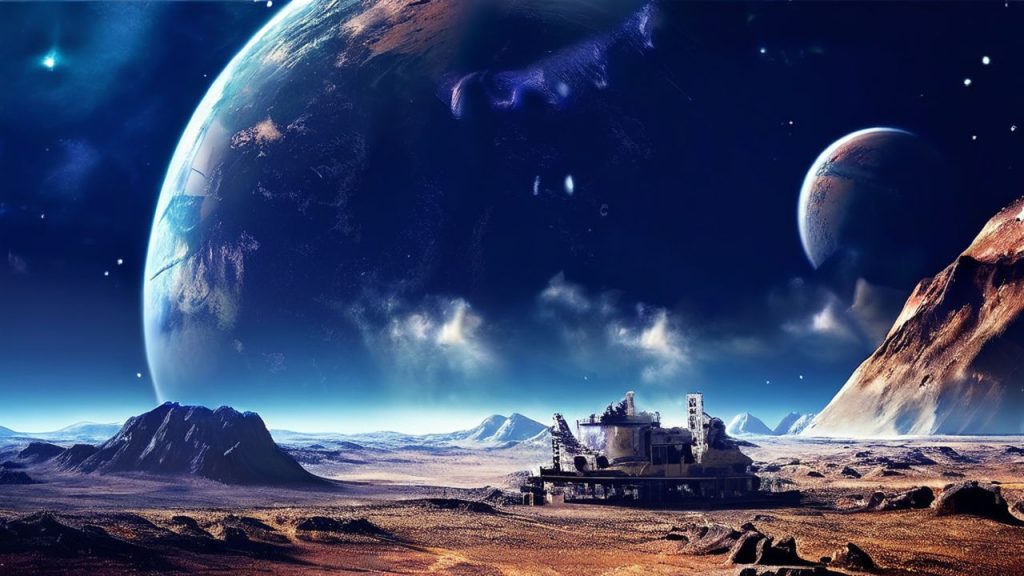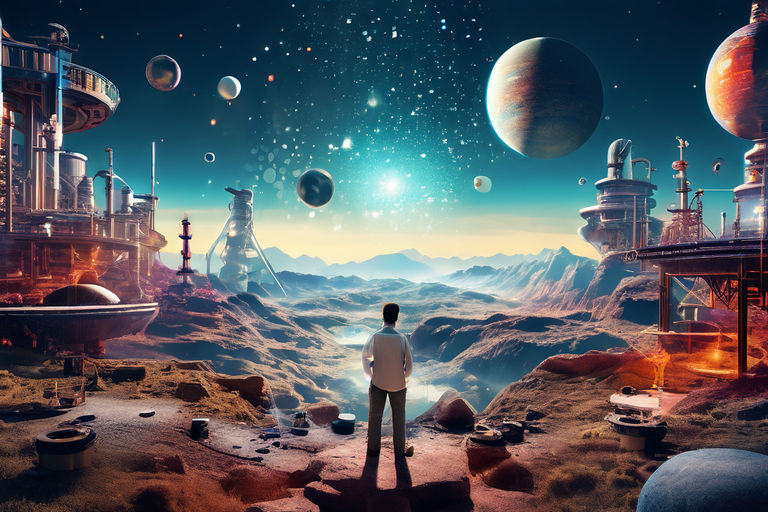Introduction
Humanity has always been drawn to the mysteries that lie beyond the confines of Earth. Since ancient times, when early civilizations gazed up at the twinkling stars with wonder and awe, the idea of venturing into the vast unknown of space has captured our imagination.
From the earliest recorded history, we find evidence of cultures attempting to understand and interpret the celestial bodies that adorn the night sky. Whether through mythological stories that imbued the stars with divine significance or through the meticulous observations of astronomers like Ptolemy and Copernicus, the desire to comprehend the cosmos has been a constant thread in human history.
As our understanding of science and technology has advanced, so too has our ability to explore the cosmos. What was once the realm of myth and speculation has now become the domain of scientists, engineers, and astronauts. From the first tentative steps into space during the Cold War era to the ambitious plans for interstellar travel in the future, the journey of space exploration reflects both our innate curiosity and our boundless ambition as a species.
In this article, we will delve into the captivating history of space exploration, tracing the remarkable achievements, the monumental challenges, and the extraordinary visionaries who have shaped our quest to reach for the stars. Join us on a journey through time and space as we explore the history of humanity’s greatest adventure: the exploration of the cosmos.
Early Concepts of Space Exploration
Pre-20th Century Visions
Since the dawn of civilization, humans have looked to the skies with wonder and curiosity. Ancient cultures across the globe, from the Egyptians to the Mayans, developed elaborate cosmologies and mythologies to explain the movements of the stars and planets. These early civilizations viewed the heavens as a realm of gods and celestial beings, influencing everything from religious rituals to agricultural calendars.
One of the earliest recorded attempts at conceptualizing space travel can be found in the writings of the ancient Greeks. Visionaries like Archytas of Tarentum and Hero of Alexandria speculated about the possibility of constructing flying machines powered by steam or compressed air. While these ideas remained purely theoretical, they laid the groundwork for later innovations in aerodynamics and propulsion.
During the Renaissance, the polymath Leonardo da Vinci famously sketched designs for flying machines that resembled modern-day helicopters and parachutes. Although these inventions were never built during his lifetime, da Vinci’s visionary concepts demonstrated an early understanding of the principles of aerodynamics and flight.
The Advent of Modern Rocketry
The true birth of modern rocketry can be traced back to the pioneering work of Konstantin Tsiolkovsky, a Russian scientist and mathematician. In the late 19th and early 20th centuries, Tsiolkovsky formulated the mathematical equations that govern the motion of rockets in a vacuum, known today as the “rocket equation.” This groundbreaking work laid the theoretical foundation for future developments in space travel and rocket propulsion.
Tsiolkovsky’s insights into the physics of space travel inspired a new generation of scientists and engineers to explore the possibilities of rocket propulsion. His visionary ideas laid the groundwork for the development of liquid-fueled rockets, which would later propel humanity beyond the confines of Earth’s atmosphere.
In addition to his theoretical work, Tsiolkovsky also envisioned ambitious concepts for space exploration, including the use of multi-stage rockets and space stations. Although many of his ideas were ahead of their time, they provided the inspiration and motivation for future generations to turn dreams of space travel into reality.
The Space Race
The Cold War Era
The mid-20th century was dominated by the geopolitical tensions between the United States and the Soviet Union, a period known as the Cold War. As both superpowers vied for global supremacy, competition extended beyond earthly boundaries to the uncharted realms of space.
The rivalry between the United States and the Soviet Union was characterized by a series of technological and ideological showdowns, with space exploration emerging as a critical battleground. The perceived strategic advantages of controlling space fueled a fierce race to achieve significant milestones in space exploration.
Sputnik and Beyond
On October 4, 1957, the Soviet Union shocked the world by launching Sputnik 1, the first artificial satellite, into orbit around the Earth. This historic achievement marked the dawn of the space age and served as a potent symbol of Soviet technological prowess. The successful launch of Sputnik not only demonstrated the Soviet Union’s capability to deliver payloads into space but also raised concerns in the United States about the potential military implications of space travel.
Following the launch of Sputnik, the Soviet Union continued to achieve significant milestones in space exploration, including the first human spaceflight by Yuri Gagarin in 1961. These achievements further heightened the sense of urgency in the United States to catch up and assert its dominance in space.
NASA and Apollo Missions
In response to the Soviet Union’s early successes in space, the United States established the National Aeronautics and Space Administration (NASA) in 1958. NASA’s primary mission was to explore space and develop technologies that would enable humans to travel beyond Earth’s atmosphere.
One of NASA’s most iconic achievements came with the Apollo missions, a series of crewed lunar exploration missions launched between 1961 and 1972. The crowning moment of the Apollo program came on July 20, 1969, when NASA astronaut Neil Armstrong became the first human to set foot on the surface of the moon during the Apollo 11 mission. Armstrong’s famous words, “That’s one small step for [a] man, one giant leap for mankind,” echoed around the world and symbolized a triumph of human ingenuity and perseverance.
The Apollo missions represented the pinnacle of American technological achievement and marked the United States’ victory in the Space Race. However, the legacy of the Space Race extended far beyond national pride, shaping the course of scientific exploration and inspiring future generations to reach for the stars.
Space Stations and Beyond
The Mir Space Station
In the realm of space exploration, the concept of a space station has long captured the imagination of scientists and engineers. The Soviet Union made history in 1971 with the launch of Salyut 1, the world’s first space station. However, it was the subsequent development of the Mir space station that truly revolutionized human presence in space.
Launched in 1986, Mir represented a significant leap forward in space station technology. Unlike its predecessors, Mir was designed as a modular space station, allowing for the continuous expansion and reconfiguration of its living and working quarters. Over the course of its operational life, Mir served as a laboratory for scientific research, a platform for international cooperation, and a symbol of human endurance in the harsh environment of space.
International Space Station (ISS)
The crowning achievement of international collaboration in space exploration is the International Space Station (ISS). Conceived in the aftermath of the Cold War, the ISS represents a partnership between five space agencies: NASA (United States), Roscosmos (Russia), ESA (European Space Agency), JAXA (Japan Aerospace Exploration Agency), and CSA (Canadian Space Agency).
Construction of the ISS began in 1998 with the launch of the Russian Zarya module, followed by the American Unity module. Over the next two decades, additional modules and components were added, culminating in the completion of the ISS in 2011. Since then, the ISS has served as a one-of-a-kind laboratory for scientific research, technology development, and international cooperation in space.
Exploration of Mars and Beyond
While space stations have provided invaluable insights into the challenges of long-duration spaceflight, the ultimate goal of human exploration lies beyond Earth’s orbit. Mars, with its potential for harboring life and resources, has long captured the imagination of scientists and explorers.
In recent decades, robotic missions to Mars have paved the way for future human exploration. NASA’s Mars rovers, including Curiosity and Perseverance, have explored the Martian surface, conducting experiments and gathering data to better understand the planet’s geology, climate, and potential for supporting life.
These robotic missions represent just the first steps in humanity’s journey to the Red Planet. Plans for crewed missions to Mars are already in the works, with space agencies and private companies around the world racing to develop the technology and infrastructure needed to send humans to the Martian surface.
Private Space Exploration
Emergence of Commercial Space Companies
In recent years, the landscape of space exploration has undergone a profound transformation with the emergence of commercial space companies. Led by visionary entrepreneurs such as Elon Musk and Jeff Bezos, these companies are revolutionizing the way we think about space travel and exploration.
One of the most prominent players in the commercial space industry is SpaceX, founded by Elon Musk in 2002. SpaceX’s ambitious goal is to reduce the cost of space travel and enable the colonization of other planets, starting with Mars. Through a combination of innovative engineering and relentless ambition, SpaceX has achieved numerous milestones, including the first privately-funded spacecraft to reach orbit (Dragon) and the first privately-funded spacecraft to dock with the International Space Station (ISS).
Blue Origin, founded by Amazon founder Jeff Bezos in 2000, is another major player in the commercial space sector. Blue Origin is focused on developing reusable rocket technology and building infrastructure for future space exploration. The company’s New Shepard rocket has successfully completed multiple suborbital flights, paving the way for future crewed missions to space.
In addition to SpaceX and Blue Origin, a host of other private companies are also making significant contributions to the commercial space industry. From satellite deployment and telecommunications to asteroid mining and space tourism, these companies are exploring a wide range of opportunities in space.
Reusable Rocket Technology
One of the most significant advancements in recent years has been the development of reusable rocket technology. Traditionally, rockets were used only once, resulting in exorbitant costs for each launch. However, SpaceX’s successful development of reusable rockets has revolutionized the economics of space travel.
By landing the first stage of its Falcon 9 rockets back on Earth after launch, SpaceX has dramatically reduced the cost of launching payloads into space. Reusable rocket technology not only makes space travel more affordable but also enables rapid turnaround times between launches, opening up new possibilities for commercial and scientific missions in space.
The success of SpaceX’s reusable rocket technology has inspired other companies to pursue similar innovations, further driving down the cost of space travel and accelerating the pace of exploration and discovery in the final frontier.
Challenges and Future Prospects
Space Debris
As humanity continues to venture deeper into space, we face an increasingly urgent challenge: space debris. Orbiting the Earth at speeds of up to 17,500 miles per hour, space debris consists of defunct satellites, spent rocket stages, and fragments from collisions between spacecraft. This growing cloud of debris poses a significant threat to future space missions, spacecraft, and even astronauts.
The proliferation of space debris not only increases the risk of collisions but also creates a hazardous environment for satellites and other spacecraft in orbit. Collisions with even small fragments of debris can cause catastrophic damage to critical systems, leading to the loss of valuable assets and endangering human lives.
Addressing the problem of space debris will require international cooperation and innovative technological solutions. From improved tracking and monitoring systems to the development of debris removal technologies, efforts are underway to mitigate the threat posed by space debris and ensure the long-term sustainability of space exploration.

Exploration Beyond Mars
While Mars has long been a focal point of human space exploration, the future holds exciting possibilities for venturing even further into the cosmos. Plans are already underway for crewed missions to asteroids, the Moon, and eventually Mars, with space agencies and private companies around the world actively working to turn these visions into reality.
Crewed missions to asteroids hold the promise of unlocking valuable resources and furthering our understanding of the early solar system. The Moon, with its proximity to Earth and abundance of resources, represents a natural stepping stone for future deep space exploration. NASA’s Artemis program aims to return humans to the lunar surface by the mid-2020s, laying the groundwork for sustained human presence and eventual exploration of Mars.
Beyond Mars, the dream of interstellar travel beckons. While traveling to other star systems remains a theoretical concept, researchers are actively exploring the challenges and possibilities of traversing the vast distances between stars. From advanced propulsion systems to novel approaches to space travel, the quest for interstellar exploration represents the next frontier of human ambition and ingenuity.
Interstellar Travel
Interstellar travel, the concept of traveling between stars, has captured the imagination of scientists and science fiction enthusiasts alike for centuries. However, the challenges of interstellar travel are formidable, requiring breakthroughs in propulsion technology, energy generation, and life support systems.
One of the greatest challenges of interstellar travel is the vast distances involved. Even the closest star system to our own, Alpha Centauri, is over four light-years away, meaning that conventional spacecraft would take thousands of years to reach their destination. Overcoming this hurdle will require the development of revolutionary propulsion systems capable of reaching relativistic speeds, allowing spacecraft to cover vast distances in a reasonable amount of time.
Additionally, interstellar travel presents significant challenges in terms of energy generation and life support systems. Spacecraft traveling for decades or even centuries will need to be self-sustaining, capable of generating power, recycling resources, and supporting the health and well-being of their crew over extended periods of time.
While the challenges of interstellar travel are daunting, the potential rewards are equally tantalizing. Exploring nearby star systems could unlock new insights into the nature of the universe, the possibility of extraterrestrial life, and our place in the cosmos.
FAQs About Space Exploration
- What was the first object launched into space?
- The Soviet Union launched the first artificial satellite, Sputnik 1, into space on October 4, 1957.
- Who was the first human to walk on the moon?
- Neil Armstrong, an American astronaut, became the first human to set foot on the lunar surface during the Apollo 11 mission on July 20, 1969.
- How many countries have launched objects into space?
- Over 70 countries have launched satellites or other objects into space since the dawn of the space age.
- What is the International Space Station (ISS)?
- The ISS is a habitable artificial satellite in low Earth orbit where astronauts from various countries conduct scientific research and experiments.
- How do astronauts eat in space?
- Astronauts consume specially prepared and packaged foods, often rehydrated with water, since traditional cooking methods are not feasible in microgravity.

















No Comments
Leave a comment Cancel